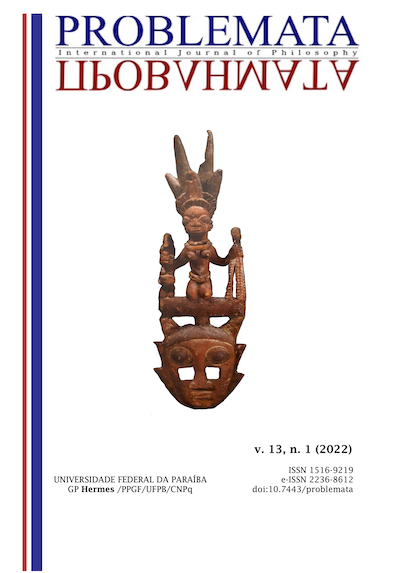THE CONCEPT OF ÌWÀ IN YORÙBÁ AESTHETICS
DOI:
https://doi.org/10.7443/problemata.v13i1.63351Palavras-chave:
Estética Yorubá, Ìwà, Caráter, Beleza, ExistênciaResumo
Este artigo explorará o conceito de ìwà, geralmente traduzido como “caráter” e suas possíveis implicações para o estudo da estética iorubá. Partindo do adágio iorubá que afirma “ìwà l’ẹwà”, ou seja, ìwà constitui beleza, o artigo buscará explicitar de que maneiras a categoria que fora usualmente como ética, o caráter (ìwà) esteve, no pensamento e na arte iorubás internamente vinculado com a ideia de beleza (ẹwà). A relação entre os conceitos iorubás de caráter e existência também serão explorados a partir da arte e da percepção iorubana dos orixás, divindades com complexas relações com o domínio da existência. O artigo também discutirá as relações entre beleza e caráter no contexto de uma distinção entre uma microestética e uma macroestética; ideias úteis para a compreensão da produção, crítica e fruição da arte entre os iorubás. Pretende-se que essa abordagem contribua para a compreensão das vinculações entre ética e estética na filosofia da arte iorubá.
Downloads
Referências
ABIMBỌLA, Wande. Ìwàpẹ̀lẹ́: The Concept of Good Character in Ifa Literary Corpus. In: ABIMBỌLA, Wande. Yoruba Oral Tradition. Ife: Department of African Languages and Literatures, 1975.
ABIODUN, Rowland. Ifa Art Objects: An Interpretation based on Oral Traditions. In ABIMBOLA, Wande (ed.). Yoruba Oral Tradition. Ile-Ife: Departamento de Línguas e Literaturas Africanas; 1975a.
ABIODUN, Rowland. Naturalism in Primitive Art: A survey of Attitudes, Odu, A Journal of West African Studies, Rowland Abiodun.- N.S. No. II, 1975b.
ABIODUN, Rowland. A Reconsideration of the Function of Ako, Second Burial Effigy in Owo. AFRICA, Journal of the International African Institute. n. 1, 1976, p. 4-20.
ABIODUN, Rowland Abiodun. Mythical Allusions in Yorùbá Ritualistic Art: Orí-lnú, Verbal and Visual metaphor’ in Verbal and Visual Arts in Africa, Rowland Abiodun; ed. Dan Ben-Amos. - Bloomington: Indiana University Press, no prelo.
ABRAHAM, R. C. Dictionary of Modem Yoruba. London: University of London Press, 1970.
ADENIJI, David. Comunicação pessoal, maio de 1974.
AJIBOLA, J.O. Owe Yoruba, J.O. Ajibola . - Ibadan: OUP, 1971
AKIRINDE, Ajadi. Oríkì Àwọn Òṣise. Ibadan: Daystar Press, 1978.
AKIWỌWỌ, Chief Akinbiyi. Comunicação pessoal. Setembro de 1976.
BAMGBOṢE, Ayọ. A Short Yoruba Grammar. Ibadan: Heinemann, 1967.
BEIER, Ulli. African Mud Sculpture. Cambridge: Cambridge University Press, 1963.
IDOWU, Bolaji, Olodumare, Bolaji Idowu.-London: Longman, 1962.
ISOLA, Akinwumi. Comunicação pessoal, Janeiro de 1975.
LAWAL, Babatunde. Some Aspects of Yoruba Aesthetics. British Journal of Aesthetics, 14, 1974, p. 239-249.
MORAKINYO, Olufemi; AKIWOWO, Akinsola. The Yoruba Ontology of Personality and Motivation: A Multidisciplinary Approach. Journal of Social Biol. Struct, 4, 1981, p. 19-38.
OGUNNIRAM, Lawuyi. ‘F’ẹsọ Jaiye” in Ewì Ìwòyí, Lawuyi Ogunniran; Adeagbo Akinjogbin, ed., Glasgow: Collins, 1969.
ONIONS, C.F. (ed.). Shorter Oxford Dictionary, Vol. 1, 3rd edition, Oxford: OUP: 1965.
SOBANDE, Adegboyega. Àwọn Owe Ilẹ Wa, Olókun,. n.7, 1967.
THOMPSON, Robert Farris. Black Gods and Kings: Yoruba Art.at UCLA. Los Angeles: Museum and Laboratories of Ethnic Arts and-Technology, 1971a.
THOMPSON, Robert Farris. The Artist in Traditional Africa. In: JOPLING, Carol (ed.). Art and Aesthetics in Primitive Societies. New York: Dutton, 1971b.
THOMPSON, Robert Farris. Yoruba Artistic Criticism. In: D’AZEVEDO, Warren L. (ed). The Traditional Artist in African Societies. Bloomington: Indiana University Press, 1973a.
THOMPSON, Robert Farris. Aesthetic of the Cool. African Arts, VII, 1, 1973b, p. 44-43, 64-67.
THOMPSON, Robert Farris. African Art in Motion. Los Angeles: University of California Press, 1974.
Downloads
Publicado
Edição
Seção
Licença
Copyright (c) 2022 Rowland Abiodun

Este trabalho está licenciado sob uma licença Creative Commons Attribution 4.0 International License.
Autores que publicam nesta revista concordam com os seguintes termos:
- Autores mantém os direitos autorais e concedem à revista o direito de primeira publicação, com o trabalho simultaneamente licenciado sob a Licença Creative Commons Attribution que permite o compartilhamento do trabalho com reconhecimento da autoria e publicação inicial nesta revista.
- Autores têm autorização para assumir contratos adicionais separadamente, para distribuição não-exclusiva da versão do trabalho publicada nesta revista (ex.: publicar em repositório institucional ou como capítulo de livro), com reconhecimento de autoria e publicação inicial nesta revista.
- Autores têm permissão e são estimulados a publicar e distribuir seu trabalho online (ex.: em repositórios institucionais ou na sua página pessoal) a qualquer ponto antes ou durante o processo editorial, já que isso pode gerar alterações produtivas, bem como aumentar o impacto e a citação do trabalho publicado (Veja O Efeito do Acesso Livre).








